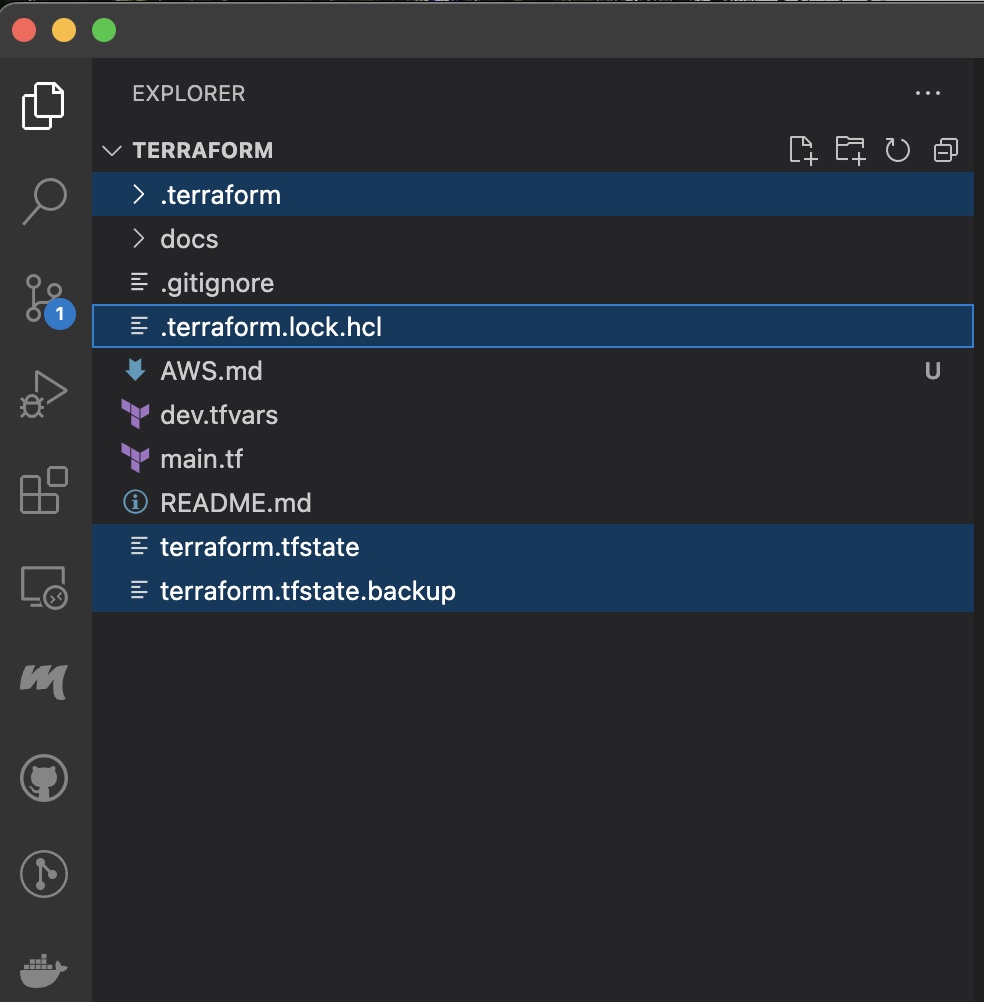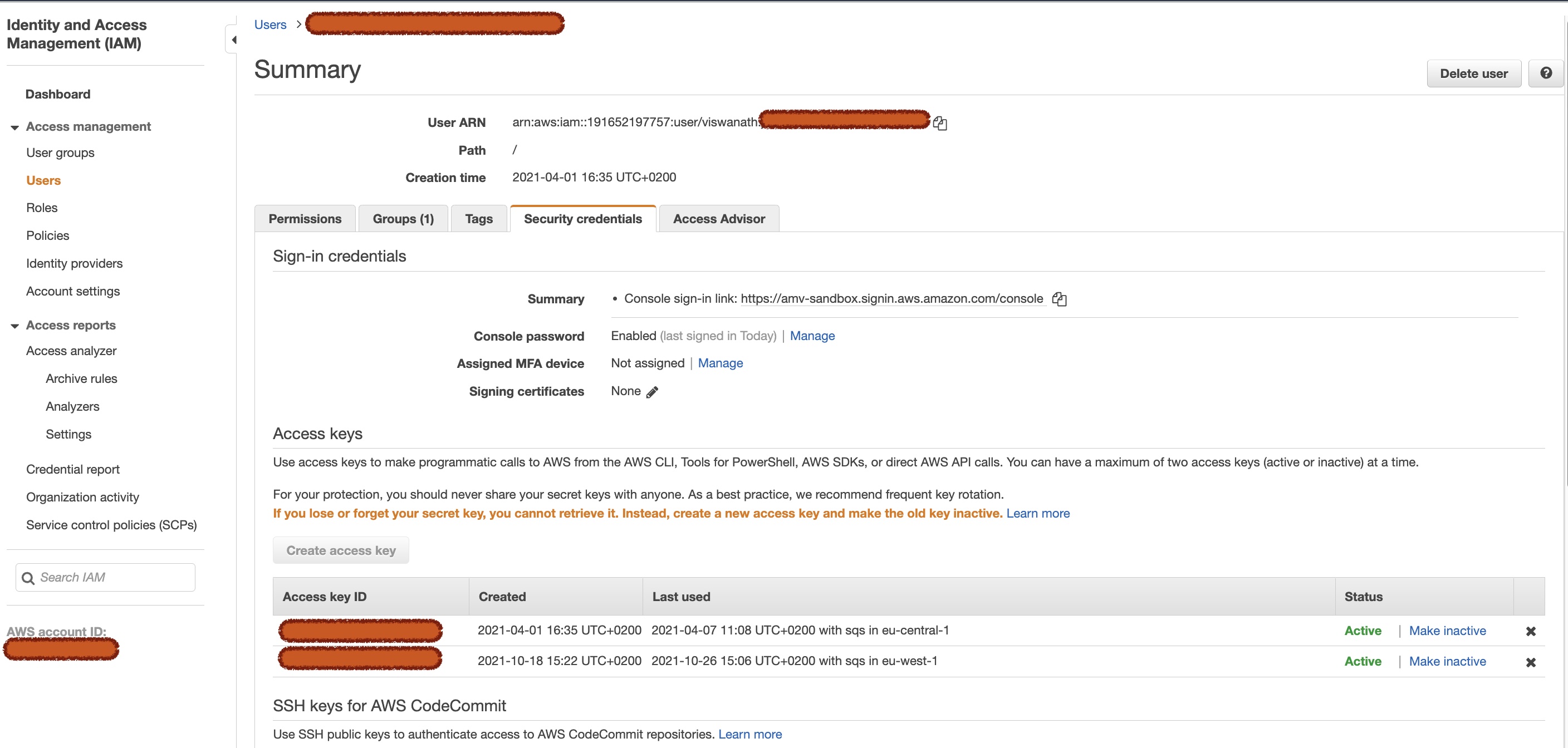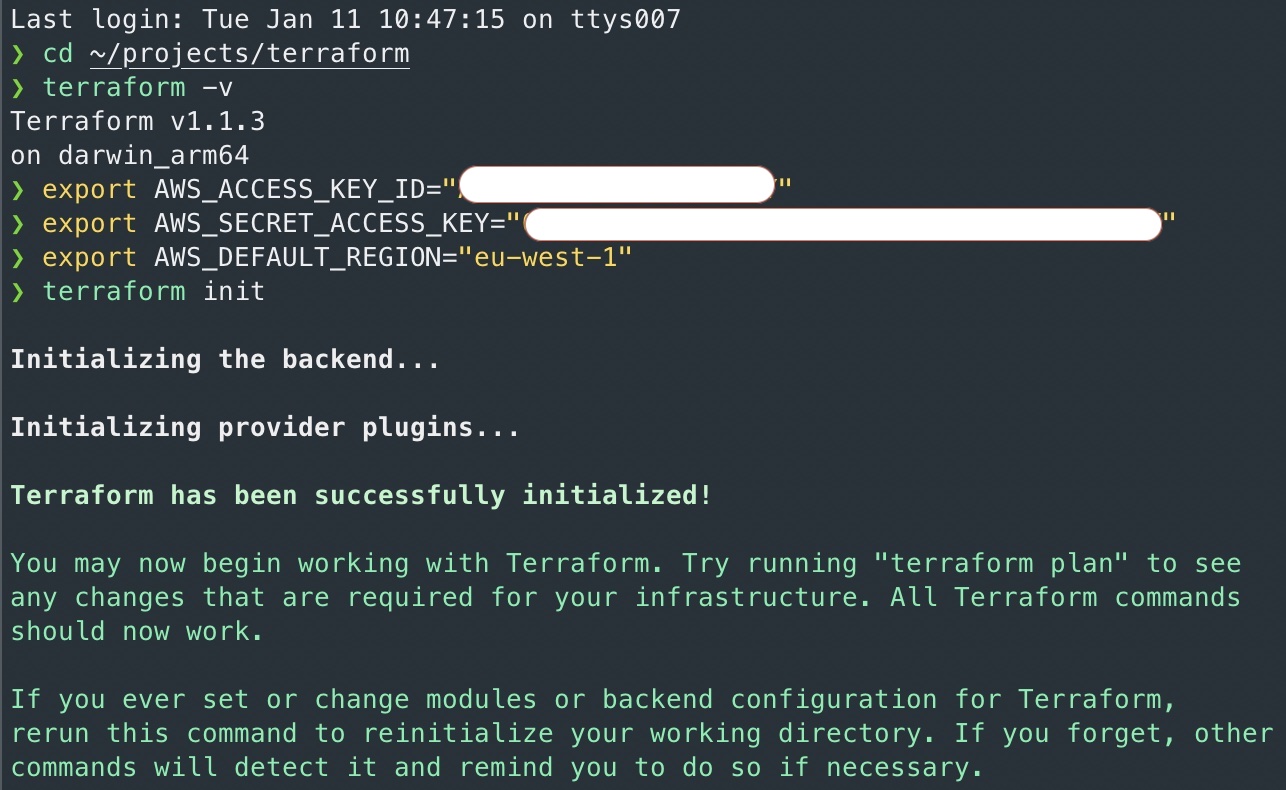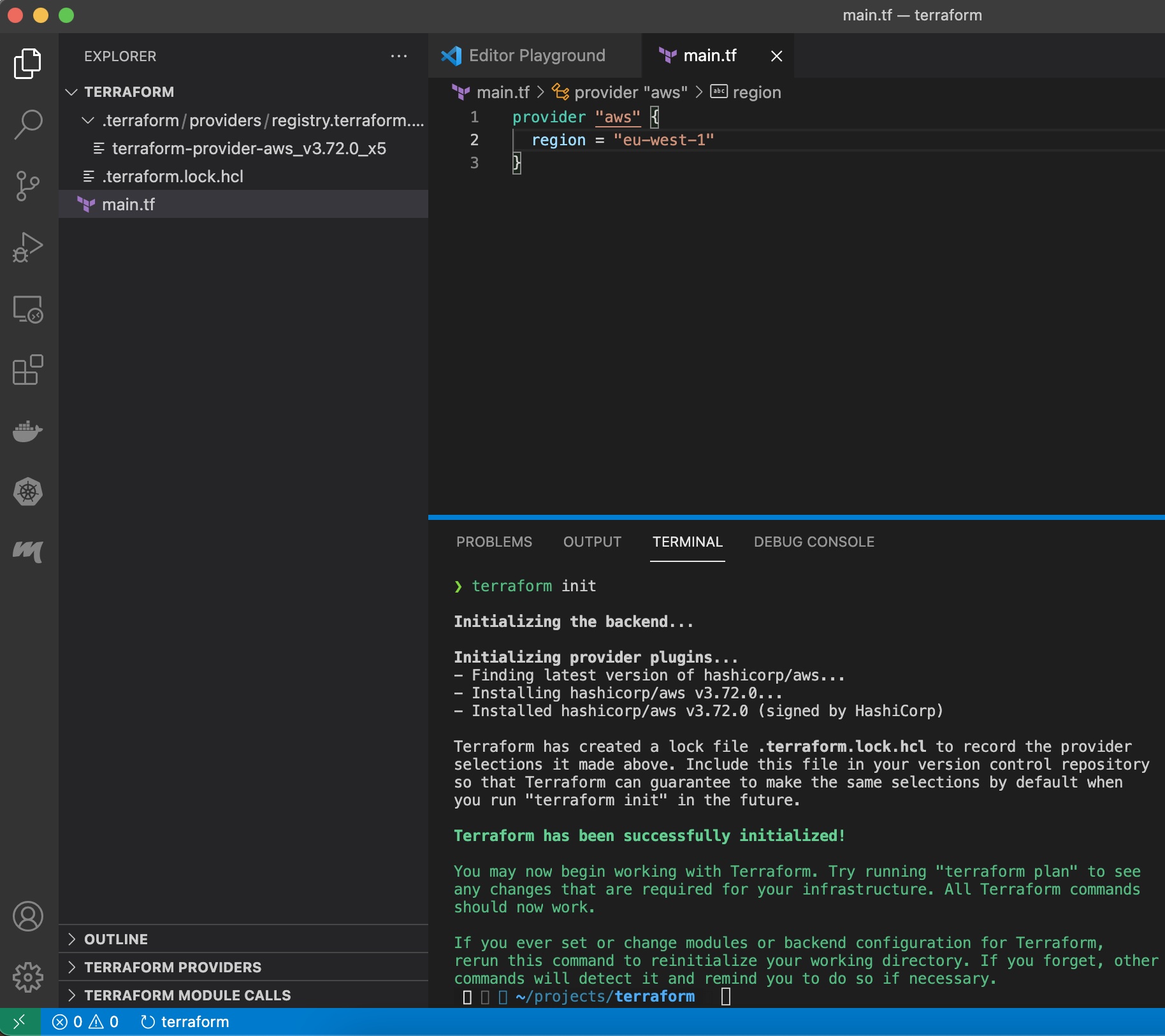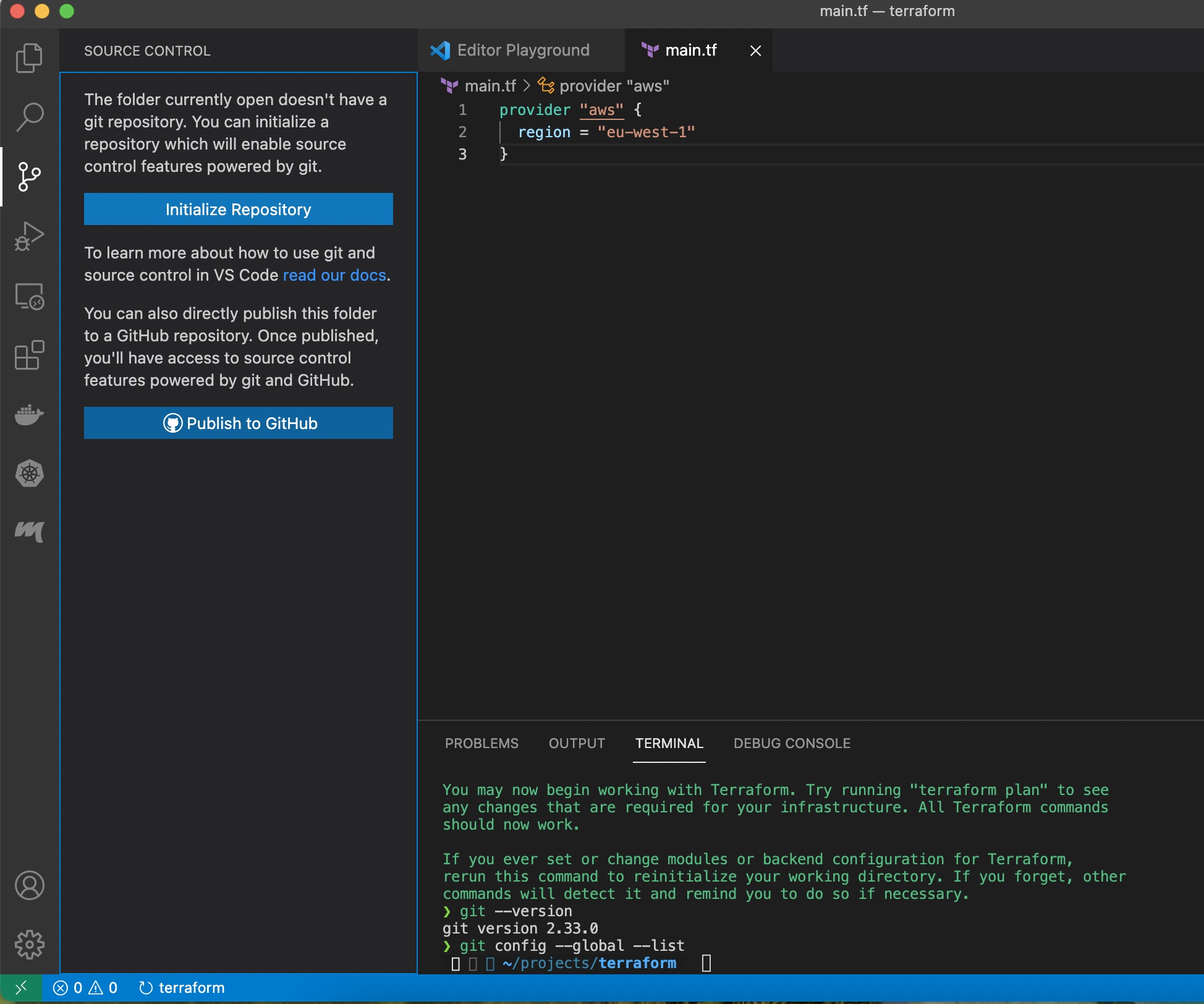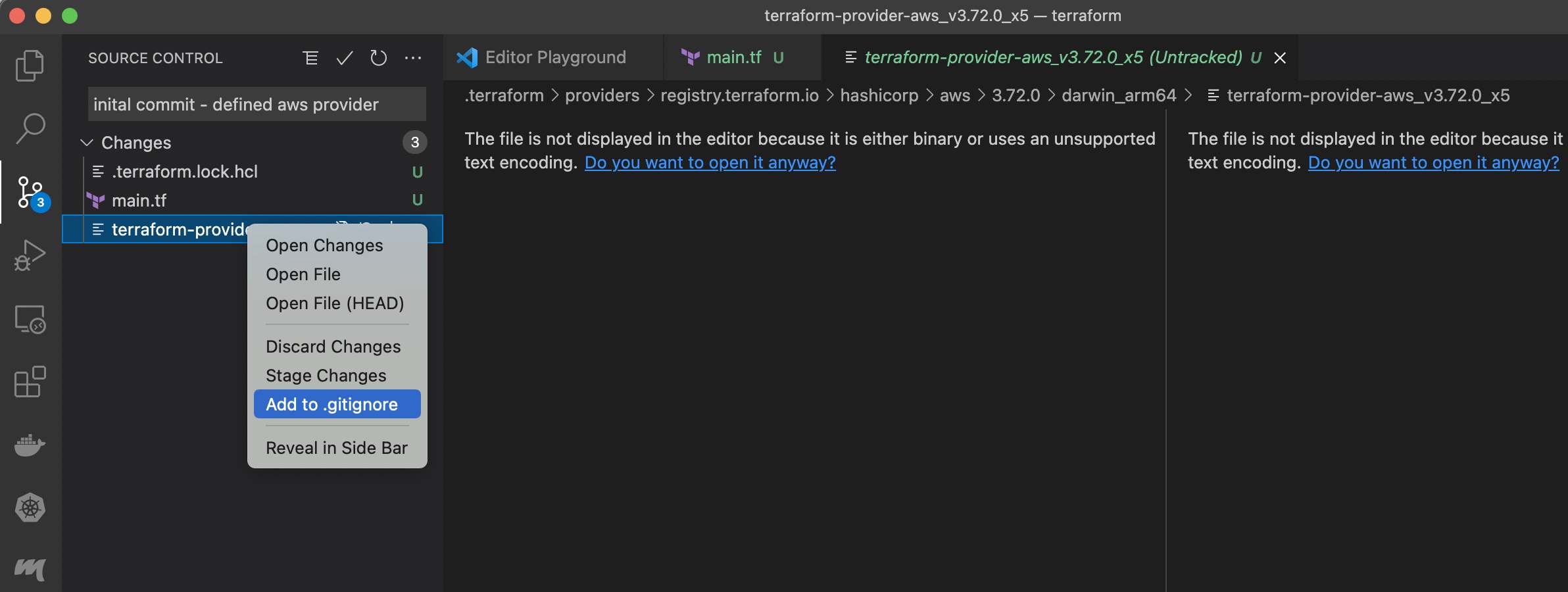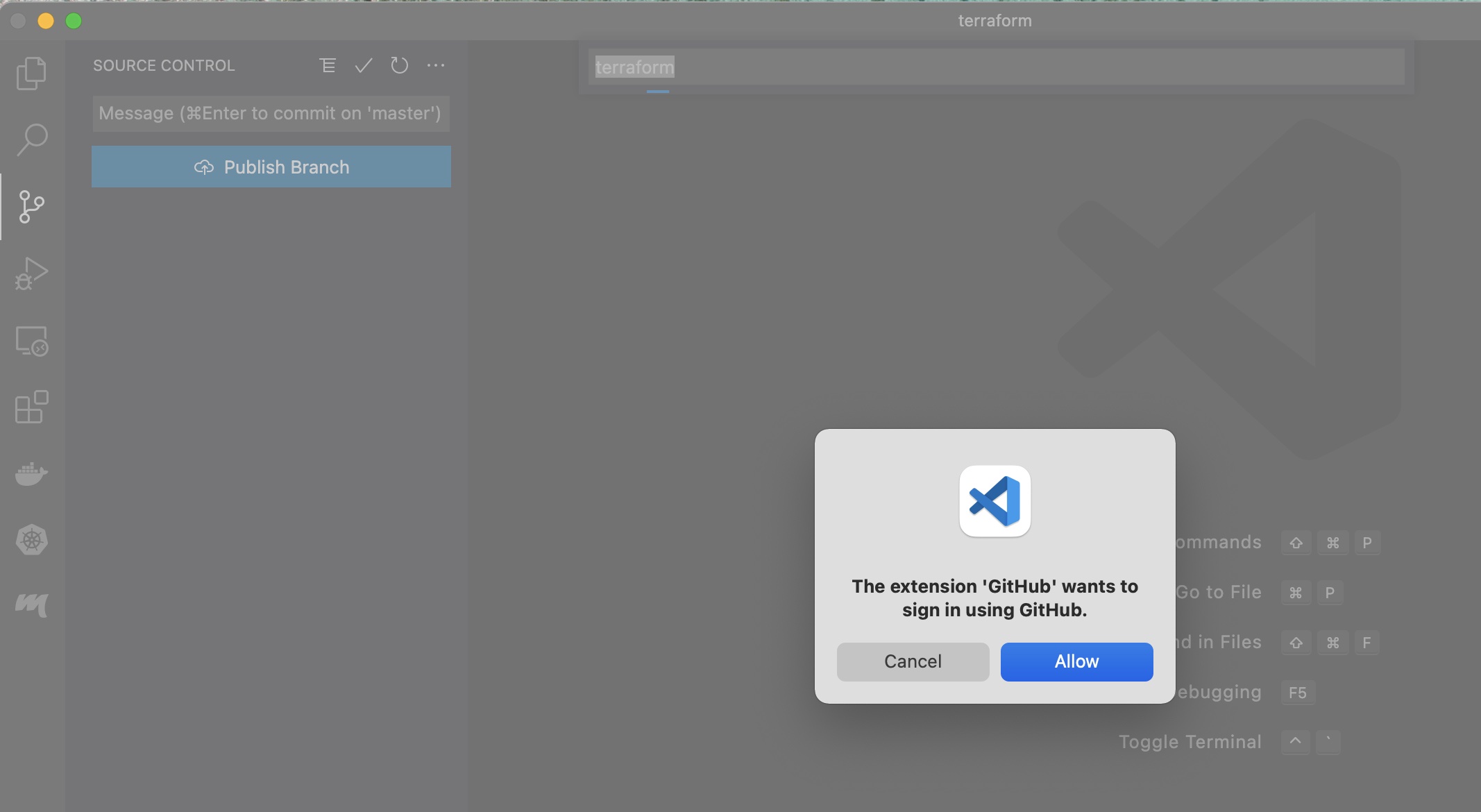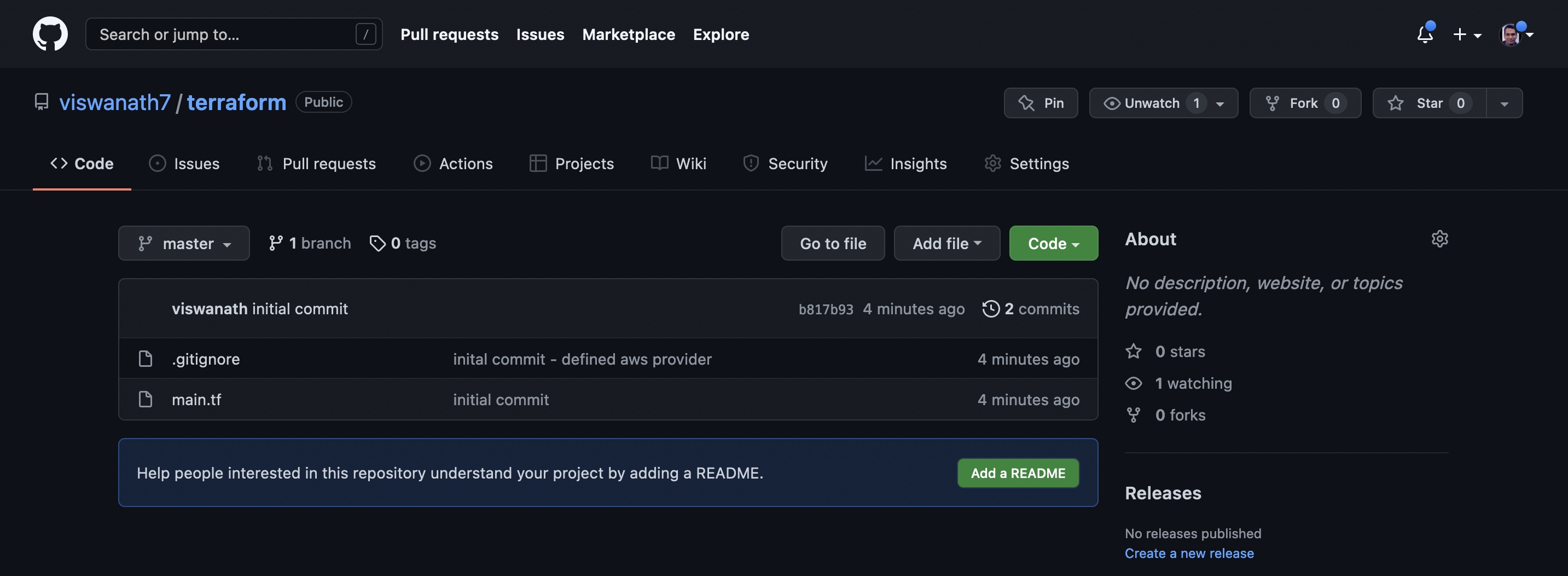On a Mac OS, one can use homebrew package manager to install Terraform as shown below
brew install terraform
Once installed, verify your installation by gathering the version of terraform installed.
❯ terraform -v
Terraform v1.1.3
on darwin_arm64
+ provider registry.terraform.io/hashicorp/aws v3.72.0
Your version of Terraform is out of date! The latest version
is 1.1.4. You can update by downloading from https://www.terraform.io/downloads.html
Provider block of the code specifies which cloud service provider, terrform shall programatically access, to automate resource management. In our case, we shall use terraform to provision infrastructure components within AWS.
provider "aws" {
region = "eu-west-1"
}
As the terraform provider code for managing resources in AWS is not pre-shipped with terraform, it must be downloaded by issuing command terraform init which places resouces under /.terraform* directory and terraform-provider-<provider-name>_<version-number>
As one needs to authenticate to manage resources, populate environment variables containing user credentials, to access AWS.
The user must possess sufficient previlege to manage resources. It is infact the same that's required for AWS CLI.
- AWS_SECRET_ACCESS_KEY
- AWS_ACCESS_KEY_ID
- AWS_DEFAULT_REGION
As the region is NOT a sensitive information, in our case, we have specified it in plain text, within provider block.
Verify the population of environment variables by issuing the command env | grep AWS
Alternatively, if one would like to globally supply credentials, ~/.aws/credentials can also be used, but note that environment variables take precedence. AWS configuration files in home directory of the user is typically created using aws configure command.
For more information, please refer to https://registry.terraform.io/providers/hashicorp/aws/latest/docs
Follow the steps as shown in the pictures below
- Initialise GIT repository
- Ignore terraform files
- Commit files
- Add VS code extension
- Publish comitted files via VS code extension
- Verify published files
Gather the current state by issuing
> terraform state list
Reference: https://registry.terraform.io/providers/hashicorp/aws/latest/docs/resources/vpc
resource "aws_vpc" "playground" {
cidr_block = "10.0.0.0/16"
tags = {
Name = "playground"
}
}
❯ terraform apply
Terraform used the selected providers to generate the following execution plan. Resource actions are indicated with the following symbols:
+ create
Terraform will perform the following actions:
# aws_vpc.playground will be created
+ resource "aws_vpc" "playground" {
+ arn = (known after apply)
+ cidr_block = "10.0.0.0/16"
+ default_network_acl_id = (known after apply)
+ default_route_table_id = (known after apply)
+ default_security_group_id = (known after apply)
+ dhcp_options_id = (known after apply)
+ enable_classiclink = (known after apply)
+ enable_classiclink_dns_support = (known after apply)
+ enable_dns_hostnames = (known after apply)
+ enable_dns_support = true
+ id = (known after apply)
+ instance_tenancy = "default"
+ ipv6_association_id = (known after apply)
+ ipv6_cidr_block = (known after apply)
+ ipv6_cidr_block_network_border_group = (known after apply)
+ main_route_table_id = (known after apply)
+ owner_id = (known after apply)
+ tags = {
+ "Name" = "playground"
}
+ tags_all = {
+ "Name" = "playground"
}
}
Plan: 1 to add, 0 to change, 0 to destroy.
Do you want to perform these actions?
Terraform will perform the actions described above.
Only 'yes' will be accepted to approve.
Enter a value: yes
aws_vpc.playground: Creating...
aws_vpc.playground: Creation complete after 5s [id=vpc-041f969f9c64bf891]
Apply complete! Resources: 1 added, 0 changed, 0 destroyed.
https://registry.terraform.io/providers/hashicorp/aws/latest/docs/resources/subnet
Use AWS CLI to gather all availibility zones for a region of choice as shown below
❯ aws ec2 describe-availability-zones --region eu-west-1
{
"AvailabilityZones": [
{
"State": "available",
"OptInStatus": "opt-in-not-required",
"Messages": [],
"RegionName": "eu-west-1",
"ZoneName": "eu-west-1a",
"ZoneId": "euw1-az1",
"GroupName": "eu-west-1",
"NetworkBorderGroup": "eu-west-1",
"ZoneType": "availability-zone"
},
{
"State": "available",
"OptInStatus": "opt-in-not-required",
"Messages": [],
"RegionName": "eu-west-1",
"ZoneName": "eu-west-1b",
"ZoneId": "euw1-az2",
"GroupName": "eu-west-1",
"NetworkBorderGroup": "eu-west-1",
"ZoneType": "availability-zone"
},
{
"State": "available",
"OptInStatus": "opt-in-not-required",
"Messages": [],
"RegionName": "eu-west-1",
"ZoneName": "eu-west-1c",
"ZoneId": "euw1-az3",
"GroupName": "eu-west-1",
"NetworkBorderGroup": "eu-west-1",
"ZoneType": "availability-zone"
}
]
}
In Terraform code, create a subnet within the VPC as shown below
resource "aws_subnet" "playground-subnet-1" {
vpc_id = aws_vpc.playground.id
cidr_block = "10.0.16.0/24"
availability_zone = "eu-west-1a"
tags = {
Name = "playground-subnet-1"
}
}
- In case one needs to refer to an existing resource instead of creating a brand new one, it can be accomplished by using data element with filter for locating the existing resource. Once located, the found resouce can be referred by using the following syntax
data.<resource-type>.<user-assigned-varaiable-name>.<property-name>. As we are creating resources from the scratch, the following approach is NOT used in our case.
data "aws_vpc" "playground-vpc" {
filter {
name = "tag:Name"
values = ["playground"]
}
}
resource "aws_subnet" "playground-subnet-2" {
vpc_id = data.aws_vpc.playground-vpc.id
cidr_block = "10.0.32.0/24"
availability_zone = "eu-west-1b"
tags = {
Name = "playground-subnet-2"
}
}
- Create the resources listed in the terraform configuration file main.tf by specifying the file that shall supply the values to variables; which is in this case dev.tfvars. The flag -auto-approve for command line execution, supresses confirmation prompts from terraform, when the resouces are created, changes or deleted. One can also preview changes using
terraform plancommand, which is executed and presented whenterraform applyis executed.
❯ terraform apply -auto-approve -var-file dev.tfvars
Terraform used the selected providers to generate the following execution plan. Resource actions are indicated with the following symbols:
+ create
Terraform will perform the following actions:
# aws_subnet.playground-subnet-1 will be created
+ resource "aws_subnet" "playground-subnet-1" {
+ arn = (known after apply)
+ assign_ipv6_address_on_creation = false
+ availability_zone = "eu-west-1a"
+ availability_zone_id = (known after apply)
+ cidr_block = "10.0.16.0/24"
+ enable_dns64 = false
+ enable_resource_name_dns_a_record_on_launch = false
+ enable_resource_name_dns_aaaa_record_on_launch = false
+ id = (known after apply)
+ ipv6_cidr_block_association_id = (known after apply)
+ ipv6_native = false
+ map_public_ip_on_launch = false
+ owner_id = (known after apply)
+ private_dns_hostname_type_on_launch = (known after apply)
+ tags = {
+ "Name" = "acme-corp-first-subnet"
}
+ tags_all = {
+ "Name" = "acme-corp-first-subnet"
}
+ vpc_id = (known after apply)
}
# aws_subnet.playground-subnet-2 will be created
+ resource "aws_subnet" "playground-subnet-2" {
+ arn = (known after apply)
+ assign_ipv6_address_on_creation = false
+ availability_zone = "eu-west-1b"
+ availability_zone_id = (known after apply)
+ cidr_block = "10.0.32.0/24"
+ enable_dns64 = false
+ enable_resource_name_dns_a_record_on_launch = false
+ enable_resource_name_dns_aaaa_record_on_launch = false
+ id = (known after apply)
+ ipv6_cidr_block_association_id = (known after apply)
+ ipv6_native = false
+ map_public_ip_on_launch = false
+ owner_id = (known after apply)
+ private_dns_hostname_type_on_launch = (known after apply)
+ tags = {
+ "Name" = "acme-corp-second-subnet"
}
+ tags_all = {
+ "Name" = "acme-corp-second-subnet"
}
+ vpc_id = (known after apply)
}
# aws_subnet.playground-subnet-3 will be created
+ resource "aws_subnet" "playground-subnet-3" {
+ arn = (known after apply)
+ assign_ipv6_address_on_creation = false
+ availability_zone = "eu-west-1c"
+ availability_zone_id = (known after apply)
+ cidr_block = "10.0.48.0/24"
+ enable_dns64 = false
+ enable_resource_name_dns_a_record_on_launch = false
+ enable_resource_name_dns_aaaa_record_on_launch = false
+ id = (known after apply)
+ ipv6_cidr_block_association_id = (known after apply)
+ ipv6_native = false
+ map_public_ip_on_launch = false
+ owner_id = (known after apply)
+ private_dns_hostname_type_on_launch = (known after apply)
+ tags = {
+ "Name" = "acme-corp-third-subnet"
}
+ tags_all = {
+ "Name" = "acme-corp-third-subnet"
}
+ vpc_id = (known after apply)
}
# aws_vpc.playground will be created
+ resource "aws_vpc" "playground" {
+ arn = (known after apply)
+ cidr_block = "10.0.0.0/16"
+ default_network_acl_id = (known after apply)
+ default_route_table_id = (known after apply)
+ default_security_group_id = (known after apply)
+ dhcp_options_id = (known after apply)
+ enable_classiclink = (known after apply)
+ enable_classiclink_dns_support = (known after apply)
+ enable_dns_hostnames = (known after apply)
+ enable_dns_support = true
+ id = (known after apply)
+ instance_tenancy = "default"
+ ipv6_association_id = (known after apply)
+ ipv6_cidr_block = (known after apply)
+ ipv6_cidr_block_network_border_group = (known after apply)
+ main_route_table_id = (known after apply)
+ owner_id = (known after apply)
+ tags = {
+ "Name" = "acme-corp"
}
+ tags_all = {
+ "Name" = "acme-corp"
}
}
Plan: 4 to add, 0 to change, 0 to destroy.
Changes to Outputs:
+ combined-local-variable = "playground-subnet"
+ vpc-arn = (known after apply)
+ vpc-first-subnet-arn = (known after apply)
+ vpc-second-subnet-arn = (known after apply)
+ vpc-third-subnet-arn = (known after apply)
aws_vpc.playground: Creating...
aws_vpc.playground: Creation complete after 5s [id=vpc-0fc984705e17df04d]
aws_subnet.playground-subnet-3: Creating...
aws_subnet.playground-subnet-2: Creating...
aws_subnet.playground-subnet-1: Creating...
aws_subnet.playground-subnet-3: Creation complete after 4s [id=subnet-0d301e0e7399b3f4a]
aws_subnet.playground-subnet-2: Creation complete after 4s [id=subnet-05340241fa99ab457]
aws_subnet.playground-subnet-1: Creation complete after 4s [id=subnet-0437f5077a94d7b14]
Apply complete! Resources: 4 added, 0 changed, 0 destroyed.
Outputs:
combined-local-variable = "playground-subnet"
vpc-arn = "arn:aws:ec2:eu-west-1:191652197757:vpc/vpc-0fc984705e17df04d"
vpc-first-subnet-arn = "arn:aws:ec2:eu-west-1:191652197757:subnet/subnet-0437f5077a94d7b14"
vpc-second-subnet-arn = "arn:aws:ec2:eu-west-1:191652197757:subnet/subnet-05340241fa99ab457"
vpc-third-subnet-arn = "arn:aws:ec2:eu-west-1:191652197757:subnet/subnet-0d301e0e7399b3f4a"
- Verify whether the resources are created properly by using
terraform statecommands as shown below.
❯ terraform state list
aws_subnet.playground-subnet-1
aws_subnet.playground-subnet-2
aws_subnet.playground-subnet-3
aws_vpc.playground
❯ terraform state show aws_vpc.playground
# aws_vpc.playground:
resource "aws_vpc" "playground" {
arn = "arn:aws:ec2:eu-west-1:191652197757:vpc/vpc-0fc984705e17df04d"
assign_generated_ipv6_cidr_block = false
cidr_block = "10.0.0.0/16"
default_network_acl_id = "acl-0e2278bb4fbe5d632"
default_route_table_id = "rtb-0ea50e0fba2833d94"
default_security_group_id = "sg-01c7bae1c42947227"
dhcp_options_id = "dopt-f4927b91"
enable_classiclink = false
enable_classiclink_dns_support = false
enable_dns_hostnames = false
enable_dns_support = true
id = "vpc-0fc984705e17df04d"
instance_tenancy = "default"
main_route_table_id = "rtb-0ea50e0fba2833d94"
owner_id = "191652197757"
tags = {
"Name" = "acme-corp"
}
tags_all = {
"Name" = "acme-corp"
}
}
Notice that the VPC is created with name and CIDR block as specified in the variables file dev.tfvars.
Custom environment variables available globally can be provisioned by using TF_VAR_ prefix. For example environment variable set using export TF_VAR_my_prop=myVal can be referred within configuration file
variable my_prop = {}
followed by var.my_prop.
